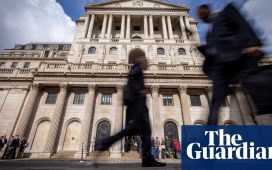Key events
Stock markets across Europe have gained ground. The FTSE 100 in London is up by 0.4%.
Here are the opening snaps from across the rest of Europe:
-
EUROPE’S STOXX 600 UP 0.1%
-
GERMANY’S DAX FLAT
-
FRANCE’S CAC 40 UP 0.2%; SPAIN’S IBEX UP 0.1%
-
EURO STOXX INDEX UP 0.1%; EURO ZONE BLUE CHIPS UP 0.1%
As trading in London has opened, yields on the UK 10-year and the 30-year have risen by about four basis points (0.04 percentage points) apiece. But they still remain just below the high for the year hit on Thursday.
That left the 10-year gilt at 4.477%, and the 30-year at 4.913%.
UK house prices slow in October; government borrowing costs nudge annual high
Good morning, and welcome to our live coverage of business, economics and financial markets.
UK house price growth slowed in October ahead of Wednesday’s budget, surprising economists who had expected faster increases, according to one of the key measures collected by a lender.
House prices grew by 0.1% in October, according to the Nationwide building society. That was less than the 0.3% rate that economists polled by Reuters.
The annual rate of growth slowed from 3.2% in September to 2.4% in October, below the 2.8% expected by economists.
Robert Gardner, Nationwide’s chief economist, said:
Housing market activity has remained relatively resilient in recent months, with the number of mortgage approvals approaching the levels seen pre-pandemic, despite the significantly higher interest rate environment.
UK debt yields revisit year high after budget
UK bond yields once more touched their highest point this year on Friday, as investors continued to digest the implications of the first Labour budget in 14 years.
The yield – effectively the UK government’s borrowing cost – on the benchmark 10-year bond reached 4.526% in global trading on Friday, matching the level hit on Thursday in the aftermath of Rachel Reeves’s budget statement as investors predicted a slower pace of interest rate cuts from the Bank of England. Since then it has fallen back slightly to 4.456%.
Scrutiny of bond market movements has been particularly intense after the budget because of the large borrowing set out by Reeves, alongside major tax increases. However, while there has been a noticeable reaction in the market for UK government bonds, also known as gilts, it has not so far been comparable to the turmoil following the budget of Liz Truss and Kwasi Kwarteng in 2022.
The below chart shows the UK 10-year gilt yield over the last three months: yields (which move inversely to prices) have risen appreciably, but the post-budget movements have not been dramatic.
We will update throughout the day on movements.
The agenda
-
9:30am GMT: S&P Global UK manufacturing purchasing managers’ index (October; final reading; previous: 51.5; consensus: 50.3)
-
12:30pm GMT: US non-farm payrolls (October: prev.: 254,000 new jobs; cons.: 113,000)
-
12:30pm GMT: US unemployment (October: prev.: 4.1%; cons.: 4.1%)









